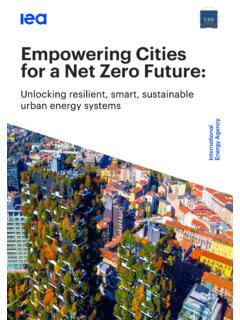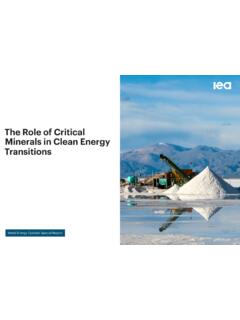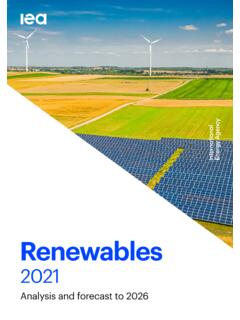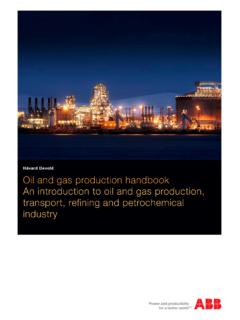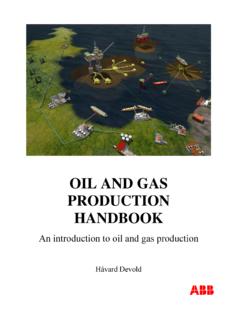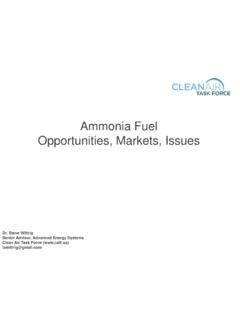Transcription of The Oil and Gas Industry in Energy Transitions
1 The Oil and Gas Industry in Energy TransitionsInsights from IEA analysis 2 | The Oil and Gas Industry in Energy Transitions | IEA 2020. All rights reserved Table of contents Contents Key findings .. 4 Section I The oil and gas Industry today ..15 Resources and production ..18 Environmental indicators ..27 Investment ..35 Section II Oil and gas in Energy Transitions ..48 Oil in the Sustainable Development Scenario ..55 natural gas in the Sustainable Development Scenario ..64 Price trajectories and sensitivities ..72 Section III Risks facing the Industry ..77 The risk of over- and under-investment.
2 79 Stranded oil and gas assets ..95 Financial performance national oil companies ..103 Financial performance publicly traded companies ..111 Section IV Strategic responses ..120 Traditional oil and gas operations ..124 Deploying carbon capture, utilisation and storage technologies ..135 Low-carbon liquids and gases in Energy Transitions ..142 The transition from fuel to Energy companies ..153 Annex ..161 3 | The Oil and Gas Industry in Energy Transitions | IEA 2020. All rights reserved IntroductionThe oil and gas Industry is facing increasing demands to clarify the implications of Energy Transitions for their operations and business models, and to explain the contributions that they can make to reducing greenhouse gas (GHG) emissions and to achieving the goals of the Paris Agreement.
3 The increasing social and environmental pressures on many oil and gas companies raise complex questions about the role of these fuels in a changing Energy economy, and the position of these companies in the societies in which they operate. But the core question, against a backdrop of rising GHG emissions, is a relatively simple one: should today s oil and gas companies be viewed only as part of the problem, or could they also be crucial in solving it? This is the topic taken up by the International Energy Agency (IEA) in this report, which builds on a multi-year programme of analysis on the future of oil and gas in the IEA World Energy Outlook (WEO) series.
4 This report does not aim to provide definitive answers, not least because of the wide diversity of oil and gas companies and company strategies around the world. It does aim to map out the risks facing different parts of the Industry , as well as the range of options and responses. Three considerations provide the boundaries for this analysis. First, the prospect of rising demand for the services that Energy provides due to a growing global population some of whom remain without access to modern Energy and an expanding global economy. Second, the recognition that oil and natural gas play critical roles in today s Energy and economic systems, and that affordable, reliable supplies of liquids and gases (of different types) are necessary parts of a vision of the future.
5 And last but far from least, the imperative to reduce Energy -related emissions in line with international climate targets. These elements may appear to be in contradiction with one another, but this is not necessarily the case. The WEO Sustainable Development Scenario (SDS) charts a path fully consistent with the Paris Agreement by holding the rise in global temperatures to well below 2 C .. and pursuing efforts to limit [it] to C , and meets objectives related to universal Energy access and cleaner air. The SDS and the range of technologies that are required to achieve it provide a benchmark for the discussion throughout this report.
6 The other scenario referenced in the analysis is the Stated Policies Scenario (STEPS), which provides an indication of where today s policy ambitions and plans would lead the Energy sector. These outcomes fall far short of the world s shared sustainability goals. The focus of this report is therefore on accelerated Energy Transitions , the forces that could bring them about whether from society, policy makers, technology, investors or the Industry itself and the implications that this would have for different parts of today s oil and gas Industry . Key findings 5 | The Oil and Gas Industry in Energy Transitions | IEA 2020.
7 All rights reserved Key findings 1. The oil and gas Industry faces the strategic challenge of balancing short-term returns with its long-term licence to operate Societies are simultaneously demanding Energy services and also reductions in emissions. Oil and gas companies have been proficient at delivering the fuels that form the bedrock of today s Energy system; the question that they now face is whether they can help deliver climate solutions. The analysis in this report highlights that this could be possible if the oil and gas Industry takes the necessary steps.
8 As such, it opens a way which some companies are already following for the oil and gas Industry to engage with the grand coalition that the IEA considers essential to tackle climate change. This effort would be greatly enhanced if more oil and gas companies were firmly and fully onboard. The costs of developing low-carbon technologies represent an investment in companies ability to prosper over the long term. Overview of the global Energy system, 2018 20%40%60%80%100%PrimaryenergyElectricity generationFinalconsumptionCO emissionsH eatElectricityRenewablesBioenergyNuclear natural gasOilC oal 6 | The Oil and Gas Industry in Energy Transitions | IEA 2020.
9 All rights reserved Key findings 2. No oil and gas company will be unaffected by clean Energy Transitions , so every part of the Industry needs to consider how to respond The Industry landscape is diverse and there is no single strategic response that will make sense for all. Attention often focuses on the Majors, seven large integrated oil and gas companies that have an outsized influence on Industry practices and direction. But the Industry is much larger: the Majors account for 12% of oil and gas reserves, 15% of production and 10% of estimated emissions from Industry operations.
10 National oil companies (NOCs) fully or majority-owned by national governments account for well over half of global production and an even larger share of reserves. There are some high-performing NOCs, but many are poorly positioned to adapt to changes in global Energy dynamics. Ownership of oil and gas reserves, production and upstream investment by company type, 2018 Note: NOCs = national oil companies; INOCs = international national oil companies. 20%40%60%80%100%ReservesProductionInvest mentReservesProductionInvestmentNOCsINOC sIndependentsMajorsOilGas 7 | The Oil and Gas Industry in Energy Transitions | IEA 2020.

